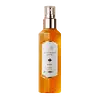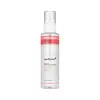What's inside
What's inside
 Key Ingredients
Key Ingredients

 Benefits
Benefits

 Concerns
Concerns

 Ingredients Side-by-side
Ingredients Side-by-side

Collagen Extract
Skin ConditioningHelianthus Annuus Seed Oil
EmollientDipropylene Glycol
Humectant1,2-Hexanediol
Skin ConditioningNiacinamide
SmoothingGlycerin
HumectantBetula Alba Bark Extract
MaskingPolypropylsilsesquioxane
Tocopherol
AntioxidantButylene Glycol
HumectantCaprylic/Capric Triglyceride
MaskingMacadamia Ternifolia Seed Oil
EmollientWater
Skin ConditioningHydroxyethyl Urea
HumectantBetaine
HumectantPersea Gratissima Oil
Skin ConditioningCamellia Seed Oil
Saccharide Isomerate
HumectantGlycine Soja Oil
EmollientEthylhexylglycerin
Skin ConditioningLauryl Glucoside
CleansingSimmondsia Chinensis Seed Oil
EmollientPentaerythrityl Tetra-Di-T-Butyl Hydroxyhydrocinnamate
AntioxidantCarthamus Tinctorius Seed Oil
MaskingOlea Europaea Fruit Oil
MaskingArgania Spinosa Kernel Oil
EmollientRosa Canina Fruit Oil
EmollientDipotassium Glycyrrhizate
HumectantDisodium EDTA
Adenosine
Skin ConditioningOenothera Biennis Oil
EmollientHydrogenated Polydecene
EmollientMannose
HumectantGlucose
HumectantAcrylates/C10-30 Alkyl Acrylate Crosspolymer
Emulsion StabilisingArginine
MaskingLunaria Annua Seed Oil
EmollientHippophae Rhamnoides Fruit Oil
Skin ProtectingCitric Acid
BufferingSodium Citrate
BufferingAgar
MaskingCyamopsis Tetragonoloba Gum
Emulsion StabilisingHydrolyzed Soy Protein
HumectantHydrolyzed Pea Protein
EmollientHydrolyzed Rice Protein
Skin ConditioningHydrolyzed Lupine Protein
Skin ConditioningHydrolyzed Potato Protein
Skin ConditioningHydrolyzed Corn Protein
Skin ConditioningHydrolyzed Oat Protein
Skin ConditioningHydrolyzed Sweet Almond Protein
Skin ConditioningHydrolyzed Barley Protein
Skin ConditioningHydrolyzed Wheat Protein
Skin ConditioningHydrolyzed Jojoba Protein
Skin ConditioningGlycoproteins
Skin ConditioningRose Flower Oil
MaskingGlutathione
Xanthan Gum
EmulsifyingPalmitoyl Pentapeptide-4
Skin ConditioningCopper Tripeptide-1
Skin ConditioningAcetyl Hexapeptide-8
HumectantParfum
MaskingLinalool
PerfumingHexyl Cinnamal
PerfumingLimonene
PerfumingCitronellol
PerfumingCollagen Extract, Helianthus Annuus Seed Oil, Dipropylene Glycol, 1,2-Hexanediol, Niacinamide, Glycerin, Betula Alba Bark Extract, Polypropylsilsesquioxane, Tocopherol, Butylene Glycol, Caprylic/Capric Triglyceride, Macadamia Ternifolia Seed Oil, Water, Hydroxyethyl Urea, Betaine, Persea Gratissima Oil, Camellia Seed Oil, Saccharide Isomerate, Glycine Soja Oil, Ethylhexylglycerin, Lauryl Glucoside, Simmondsia Chinensis Seed Oil, Pentaerythrityl Tetra-Di-T-Butyl Hydroxyhydrocinnamate, Carthamus Tinctorius Seed Oil, Olea Europaea Fruit Oil, Argania Spinosa Kernel Oil, Rosa Canina Fruit Oil, Dipotassium Glycyrrhizate, Disodium EDTA, Adenosine, Oenothera Biennis Oil, Hydrogenated Polydecene, Mannose, Glucose, Acrylates/C10-30 Alkyl Acrylate Crosspolymer, Arginine, Lunaria Annua Seed Oil, Hippophae Rhamnoides Fruit Oil, Citric Acid, Sodium Citrate, Agar, Cyamopsis Tetragonoloba Gum, Hydrolyzed Soy Protein, Hydrolyzed Pea Protein, Hydrolyzed Rice Protein, Hydrolyzed Lupine Protein, Hydrolyzed Potato Protein, Hydrolyzed Corn Protein, Hydrolyzed Oat Protein, Hydrolyzed Sweet Almond Protein, Hydrolyzed Barley Protein, Hydrolyzed Wheat Protein, Hydrolyzed Jojoba Protein, Glycoproteins, Rose Flower Oil, Glutathione, Xanthan Gum, Palmitoyl Pentapeptide-4, Copper Tripeptide-1, Acetyl Hexapeptide-8, Parfum, Linalool, Hexyl Cinnamal, Limonene, Citronellol
Water
Skin ConditioningCollagen Water
HumectantDipropylene Glycol
HumectantC13-15 Alkane
SolventRicinus Communis Seed Oil
MaskingGlycereth-26
Humectant1,2-Hexanediol
Skin ConditioningNiacinamide
SmoothingSodium Chloride
MaskingSorbitol
HumectantHydroxyethyl Urea
HumectantButylene Glycol
HumectantHelianthus Annuus Seed Oil
EmollientParfum
MaskingEthylhexylglycerin
Skin ConditioningEclipta Prostrata Extract
Skin ConditioningAdenosine
Skin ConditioningSodium Dna
Skin ConditioningMelia Azadirachta Leaf Extract
Skin ConditioningGlutathione
Paeonia Lactiflora Root Extract
Skin ConditioningMoringa Oleifera Seed Oil
EmollientCandida Bombicola/Glucose/Methyl Rapeseedate Ferment
AntimicrobialRosa Damascena Flower Water
MaskingBiotin
AntiseborrhoeicHexapeptide-2
BleachingBiotinoyl Tripeptide-1
Acetyl Hexapeptide-8
HumectantTripeptide-1
Skin ConditioningTripeptide-3
Skin ConditioningMyristoyl Pentapeptide-17
Skin ConditioningHexapeptide-9
Skin ConditioningWater, Collagen Water, Dipropylene Glycol, C13-15 Alkane, Ricinus Communis Seed Oil, Glycereth-26, 1,2-Hexanediol, Niacinamide, Sodium Chloride, Sorbitol, Hydroxyethyl Urea, Butylene Glycol, Helianthus Annuus Seed Oil, Parfum, Ethylhexylglycerin, Eclipta Prostrata Extract, Adenosine, Sodium Dna, Melia Azadirachta Leaf Extract, Glutathione, Paeonia Lactiflora Root Extract, Moringa Oleifera Seed Oil, Candida Bombicola/Glucose/Methyl Rapeseedate Ferment, Rosa Damascena Flower Water, Biotin, Hexapeptide-2, Biotinoyl Tripeptide-1, Acetyl Hexapeptide-8, Tripeptide-1, Tripeptide-3, Myristoyl Pentapeptide-17, Hexapeptide-9
 Reviews
Reviews

Ingredients Explained
These ingredients are found in both products.
Ingredients higher up in an ingredient list are typically present in a larger amount.
1,2-Hexanediol is a synthetic liquid and another multi-functional powerhouse.
It is a:
- Humectant, drawing moisture into the skin
- Emollient, helping to soften skin
- Solvent, dispersing and stabilizing formulas
- Preservative booster, enhancing the antimicrobial activity of other preservatives
Acetyl Hexapeptide-8, commonly known as Argireline or Acetyl Hexapeptide-3, is a popular peptide in skincare. It’s often referred to as a “Botox-like” ingredient because it helps reduce muscle movement.
By relaxing these micro-movements, Argireline may help minimize the appearance of fine lines and wrinkles. That said, it’s not as powerful as Botox, and research on its long-term effectiveness is still limited.
Beyond smoothing, Argireline may also support collagen production. Collagen is the protein that helps keep your skin firm, bouncy, and well-hydrated by strengthening the skin barrier.
So while Argireline isn’t a miracle fix, it can be a helpful addition to a routine focused on both prevention and skin health.
Read more about other common types of peptides here:
Learn more about Acetyl Hexapeptide-8Adenosine is in every living organism. It is one of four components in nucleic acids that helps store our DNA.
Adenosine has many benefits when used. These benefits include hydrating the skin, smoothing skin, and reducing wrinkles. Once applied, adenosine increases collagen production. It also helps with improving firmness and tissue repair.
Studies have found adenosine may also help with wound healing.
In skincare products, Adenosine is usually derived from yeast.
Learn more about AdenosineButylene Glycol (or BG) is used within cosmetic products for a few different reasons:
Overall, Butylene Glycol is a safe and well-rounded ingredient that works well with other ingredients.
Though this ingredient works well with most skin types, some people with sensitive skin may experience a reaction such as allergic rashes, closed comedones, or itchiness.
Learn more about Butylene GlycolDipropylene Glycol is a synthetically created humectant, stabilizer, and solvent.
This ingredient helps:
Dipropylene glycol is technically an alcohol, but it belongs to the glycol family (often considered part of the ‘good’ alcohols). This means it is hydrating and gentle on skin unlike drying solvent alcohols like denatured alcohol.
As a masking agent, Dipropylene Glycol can be used to cover the smell of other ingredients. However, it does not have a scent.
Studies show Dipropylene Glycol is considered safe to use in skincare.
Learn more about Dipropylene GlycolEthylhexylglycerin (we can't pronounce this either) is commonly used as a preservative and skin softener. It is derived from glyceryl.
You might see Ethylhexylglycerin often paired with other preservatives such as phenoxyethanol. Ethylhexylglycerin has been found to increase the effectiveness of these other preservatives.
Glutathione is an antioxidant naturally found in our bodies. It is made up of three amino acids: glycine, cysteine, and glutamic acid.
As an antioxidant, it prevents oxidative damage to parts of our cell.
While glutathione is said to help with fading dark spots, the results from research are inconclusive. Further studies are needed. With that said, gluthatione has been shown to protect our skin from UV-B induced damage.
This ingredient is naturally occurring in plants, animals, fungi, and some bacteria.
Learn more about GlutathioneHelianthus Annuus Seed Oil is the oil derived from the seeds of a Sunflower. Sunflower seed oil is non-fragrant. It is an emollient, meaning it helps to soften the skin.
Sunflower seed oil contains many fatty acids. The fatty acids found in sunflower seeds include (from highest amount to least): linoleic acid, myristic acid, palmitic acid, stearic acid, arachidic acid, oleic acid, and linolenic acid.
These fatty acids help the skin create ceramides. Ceramides play a role in repairing the skin barrier.
Helianthus Annuus Seed Oil helps moisturize the skin. This in turn helps the skin look more rejuvenated and smoother.
Sunflowers are rich in vitamin E.
Historians believe Indigenous cultures of North America domesticated sunflowers before corn. Thus they relied on sunflower oil for a variety of uses. One such use is moisturizing skin and hair.
Sunflower seed oil may not be fungal acne safe. We recommend speaking with a professional if you have any concerns.
Learn more about Helianthus Annuus Seed OilNiacinamide is a multitasking form of vitamin B3 that strengthens the skin barrier, reduces pores and dark spots, regulates oil, and improves signs of aging.
And the best part? It's gentle and well-tolerated by most skin types, including sensitive and reactive skin.
You might have heard of "niacin flush", or the reddening of skin that causes itchiness. Niacinamide has not been found to cause this.
In very rare cases, some individuals may not be able to tolerate niacinamide at all or experience an allergic reaction to it.
If you are experiencing flaking, irritation, and dryness with this ingredient, be sure to double check all your products as this ingredient can be found in all categories of skincare.
When incorporating niacinamide into your routine, look out for concentration amounts. Typically, 5% niacinamide provides benefits such as fading dark spots. However, if you have sensitive skin, it is better to begin with a smaller concentration.
When you apply niacinamide to your skin, your body converts it into nicotinamide adenine dinucleotide (NAD). NAD is an essential coenzyme that is already found in your cells as "fuel" and powers countless biological processes.
In your skin, NAD helps repair cell damage, produce new healthy cells, support collagen production, strengthen the skin barrier, and fight environmental stressors (like UV and pollution).
Our natural NAD levels start to decline with age, leading to slower skin repair, visible aging, and a weaker skin barrier. By providing your skin niacinamide, you're recharging your skin's NAD levels. This leads to stronger, healthier, and younger looking skin.
Another name for vitamin B3 is nicotinamide. This vitamin is water-soluble and our bodies don't store it. We obtain Vitamin B3 from either food or skincare. Meat, fish, wheat, yeast, and leafy greens contain vitamin B3.
The type of niacinamide used in skincare is synthetically created.
Learn more about NiacinamideParfum is a catch-all term for an ingredient or more that is used to give a scent to products.
Also called "fragrance", this ingredient can be a blend of hundreds of chemicals or plant oils. This means every product with "fragrance" or "parfum" in the ingredients list is a different mixture.
For instance, Habanolide is a proprietary trade name for a specific aroma chemical. When used as a fragrance ingredient in cosmetics, most aroma chemicals fall under the broad labeling category of “FRAGRANCE” or “PARFUM” according to EU and US regulations.
The term 'parfum' or 'fragrance' is not regulated in many countries. In many cases, it is up to the brand to define this term.
For instance, many brands choose to label themselves as "fragrance-free" because they are not using synthetic fragrances. However, their products may still contain ingredients such as essential oils that are considered a fragrance by INCI standards.
One example is Calendula flower extract. Calendula is an essential oil that still imparts a scent or 'fragrance'.
Depending on the blend, the ingredients in the mixture can cause allergies and sensitivities on the skin. Some ingredients that are known EU allergens include linalool and citronellol.
Parfum can also be used to mask or cover an unpleasant scent.
The bottom line is: not all fragrances/parfum/ingredients are created equally. If you are worried about fragrances, we recommend taking a closer look at an ingredient. And of course, we always recommend speaking with a professional.
Learn more about ParfumWater. It's the most common cosmetic ingredient of all. You'll usually see it at the top of ingredient lists, meaning that it makes up the largest part of the product.
So why is it so popular? Water most often acts as a solvent - this means that it helps dissolve other ingredients into the formulation.
You'll also recognize water as that liquid we all need to stay alive. If you see this, drink a glass of water. Stay hydrated!
Learn more about Water